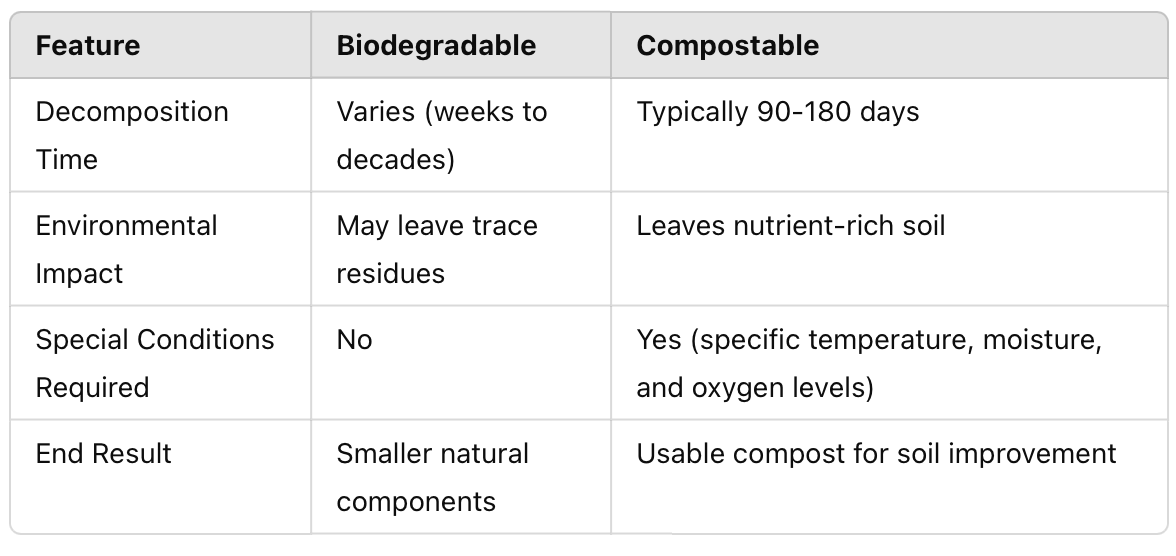
In recent years, terms like “biodegradable” and “compostable” have become buzzwords in the push for sustainability. But while many people use these words interchangeably, they have distinct meanings and environmental impacts. Understanding the differences between biodegradable and compostable materials is crucial in making informed choices that benefit the planet. Let’s break down these terms and explore their implications.
 What Does Biodegradable Mean?
What Does Biodegradable Mean?
A biodegradable material is one that can break down naturally into smaller components with the help of microorganisms like bacteria and fungi. The key feature of biodegradability is that the process does not require human intervention and does not leave behind harmful residues.
Characteristics of Biodegradable Materials:
- Break down over time through natural decomposition
- Can take weeks, months, or even years to fully degrade
- Do not necessarily require specific environmental conditions
- Can leave behind trace elements depending on the material
Common biodegradable materials include paper, certain plastics, food scraps, and natural fabrics like cotton and wool. However, the term “biodegradable” is broad, and some biodegradable materials may still take decades to decompose, especially in landfills where oxygen and moisture are limited.
 (source: https://eecloud.sgs.com/article.aspx?n=150)
(source: https://eecloud.sgs.com/article.aspx?n=150)
What Does Compostable Mean?
Compostable materials, on the other hand, are a subset of biodegradable materials, but they require specific conditions to break down completely into nutrient-rich compost. Composting is a controlled process that transforms organic waste into a substance that can enrich soil and support plant growth.
Characteristics of Compostable Materials:
- Decompose into non-toxic, nutrient-rich soil matter
- Require specific temperature, moisture, and oxygen levels
- Must break down within a certain time frame (typically within 90-180 days in industrial composting facilities)
- Leave no harmful residue
Common compostable materials include food scraps, yard waste, compostable plastics (made from plant-based materials like cornstarch), and biodegradable packaging designed for composting.
Key Differences Between Biodegradable and Compostable
 Why Does the Difference Matter?
Why Does the Difference Matter?
Understanding the difference between biodegradable and compostable materials is essential for responsible waste disposal. Labeling can sometimes be misleading—just because something is biodegradable does not mean it will break down quickly or in an environmentally friendly way.
For instance, many biodegradable plastics require industrial composting conditions to decompose efficiently. If they end up in regular landfills, they may take just as long to degrade as conventional plastics. Meanwhile, compostable materials should be disposed of in composting facilities to ensure they break down properly and provide environmental benefits.
How to Choose the Right Option
- If you have access to composting facilities, opt for compostable products to ensure waste is converted into nutrient-rich material.
- If composting is not an option, look for biodegradable items that degrade more quickly and safely in natural environments.
- Check certification labels, such as BPI (Biodegradable Products Institute) for compostable products, to confirm proper disposal methods.
Conclusion
 While both biodegradable and compostable materials can reduce environmental impact, compostable materials provide a clearer and more sustainable solution when disposed of correctly. By understanding these terms and making mindful choices, we can contribute to a greener future and reduce the burden of waste on our planet.
While both biodegradable and compostable materials can reduce environmental impact, compostable materials provide a clearer and more sustainable solution when disposed of correctly. By understanding these terms and making mindful choices, we can contribute to a greener future and reduce the burden of waste on our planet.




